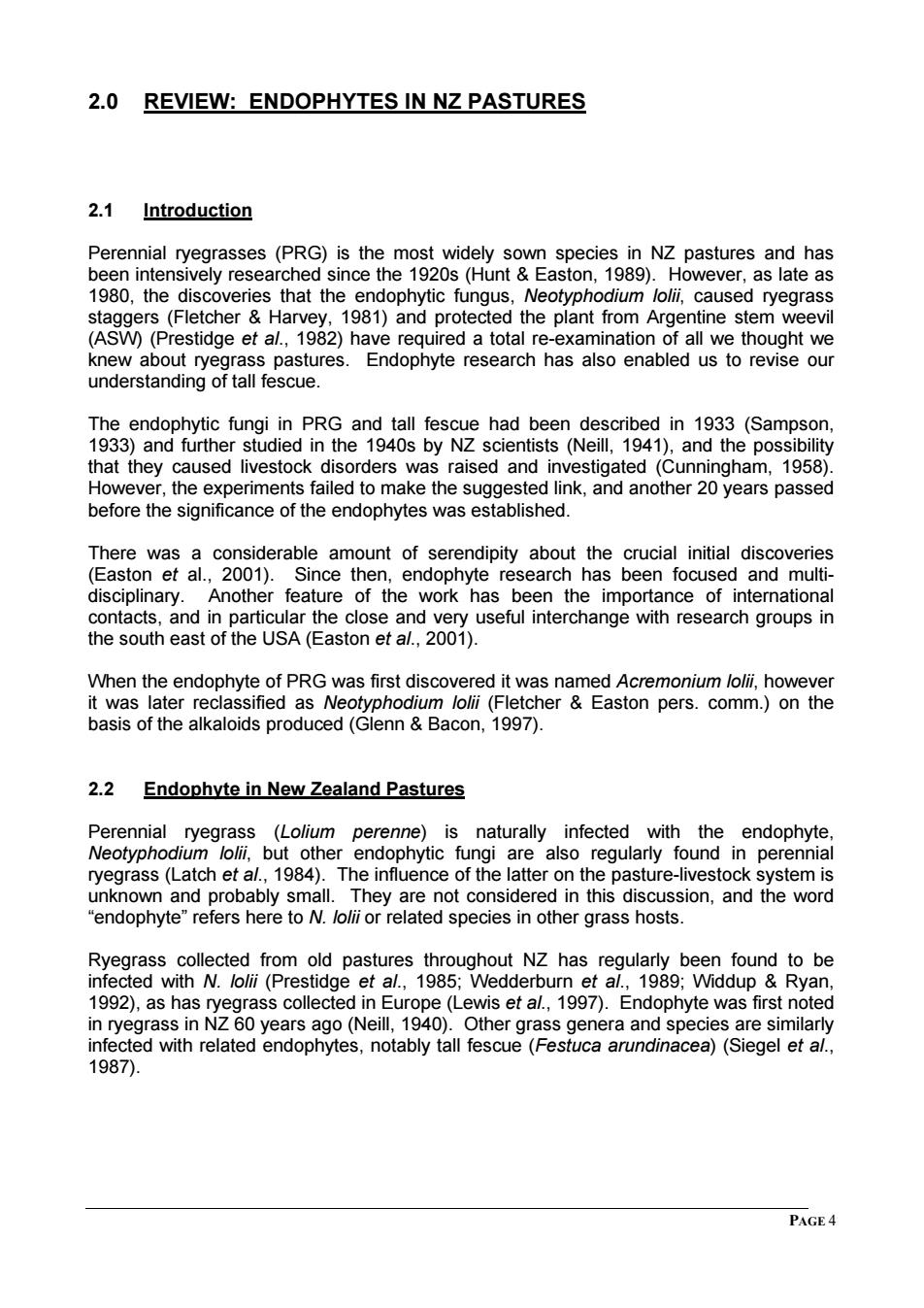正在加载图片...

2.0 REVIEW:ENDOPHYTES IN NZ PASTURES 2.1 Introduction Perennial ryegrasses(PRG)is the most widely sown species in NZ pastures and has 20s(Hunt Easton,1989).However,as late as 980,the discover that the e dophytic fungus,Neotyph m,caus d ryegrass 981)and prote e plant from Arge stidge et al. a982 total has also enab understanding The endophytic fungi in PRG and tall fescue had been described in 1933(Sampsor 1933)and further studied in the 1940s by NZ scientists (Neill,1941),and the possibility that they caused livestock disorders was raised and investigated(Cunningham,1958) However,the experiments failed to make the suggested link,and another 20 years passed before the significance of the endophytes was established. There was a considerable amount of serendipity about the crucial initial discoveries (Easton et al.,2001).Since then,endophyte research has been focused and multi USA rcangnrcp aisciplinary e etaeneatanePi monium loli,howeve r&Easton pers.comm.)on the basis of the alkaloids produced(Glenn Bacon,1997). 2.2 Endophyte in New Zealand Pastures Perennial ryegrass (Lolium perenne)is naturally infected with the endophyte Neotyphodium loli,but other endophytic fungi are also regularly found in perennia ryegrass(Latch et al.,1984).The influence of the latter on the pasture-livestock system is unknown and probably small They are not considered in this discussion,and the word "endophyte"refers here to N.lolii or related species in other grass hosts d to be 1992.ash Europe Lewis 1997 vas first n ago (Neill,1940).Other era and ecies are similarly ophytes.notably tall fescue( gel et al. 1987). PAGE42.0 REVIEW: ENDOPHYTES IN NZ PASTURES 2.1 Introduction Perennial ryegrasses (PRG) is the most widely sown species in NZ pastures and has been intensively researched since the 1920s (Hunt & Easton, 1989). However, as late as 1980, the discoveries that the endophytic fungus, Neotyphodium lolii, caused ryegrass staggers (Fletcher & Harvey, 1981) and protected the plant from Argentine stem weevil (ASW) (Prestidge et al., 1982) have required a total re-examination of all we thought we knew about ryegrass pastures. Endophyte research has also enabled us to revise our understanding of tall fescue. The endophytic fungi in PRG and tall fescue had been described in 1933 (Sampson, 1933) and further studied in the 1940s by NZ scientists (Neill, 1941), and the possibility that they caused livestock disorders was raised and investigated (Cunningham, 1958). However, the experiments failed to make the suggested link, and another 20 years passed before the significance of the endophytes was established. There was a considerable amount of serendipity about the crucial initial discoveries (Easton et al., 2001). Since then, endophyte research has been focused and multidisciplinary. Another feature of the work has been the importance of international contacts, and in particular the close and very useful interchange with research groups in the south east of the USA (Easton et al., 2001). When the endophyte of PRG was first discovered it was named Acremonium lolii, however it was later reclassified as Neotyphodium lolii (Fletcher & Easton pers. comm.) on the basis of the alkaloids produced (Glenn & Bacon, 1997). 2.2 Endophyte in New Zealand Pastures Perennial ryegrass (Lolium perenne) is naturally infected with the endophyte, Neotyphodium lolii, but other endophytic fungi are also regularly found in perennial ryegrass (Latch et al., 1984). The influence of the latter on the pasture-livestock system is unknown and probably small. They are not considered in this discussion, and the word “endophyte” refers here to N. lolii or related species in other grass hosts. Ryegrass collected from old pastures throughout NZ has regularly been found to be infected with N. lolii (Prestidge et al., 1985; Wedderburn et al., 1989; Widdup & Ryan, 1992), as has ryegrass collected in Europe (Lewis et al., 1997). Endophyte was first noted in ryegrass in NZ 60 years ago (Neill, 1940). Other grass genera and species are similarly infected with related endophytes, notably tall fescue (Festuca arundinacea) (Siegel et al., 1987). PAGE 4